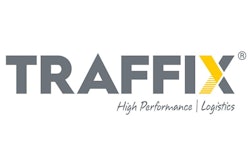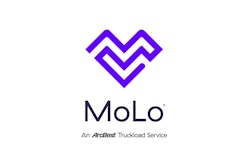
Many of today's supply chain companies are tasked with providing the utmost in visibility. Whether it's tracking reverse logistics, implementing financial software or upgrading sourcing solutions, collaborations and partnerships are what make supply chain projects a success.
That's why it's important to celebrate those projects (and partnerships). Because collaboration is the key to companies successfully completing projects in a timely, safe and efficient manner.
Meet the winners of this year's Top Supply Chain Projects award.
This year's supply chain projects focused on sustainability, automation, streamlining manual processes, enhancing traceability, mitigating risk and optimizing the overall supply chain.
Let's meet the overall winner for Food Logistics.
 GSF’s Opelika, Ala., protein products facility implemented cutting-edge robotics and a vision inspection system that automates patty production.Golden State Foods
GSF’s Opelika, Ala., protein products facility implemented cutting-edge robotics and a vision inspection system that automates patty production.Golden State Foods
Golden State Foods
www.goldenstatefoods.com
Sector: Food production, Food supplier, manufacturing
Customer client: Golden State Foods
About the project: Long-time industry standards have included a production workforce that manually ensures patties are up to standard, while fulfilling packaging needs. This method requires food production associates to physically inspect each individual burger patty for imperfections, deformities and safety hazards. Golden State Foods (GSF) emerged on the leading edge of innovative solutions to overcome this persistent challenge.
Solution: GSF’s Opelika, Ala., protein products facility implemented cutting-edge robotics and a vision inspection system that automates patty production, transforming how GSF inspects and processes burger patties, setting a new benchmark in food safety and production standards. The Opelika system integrates high-speed laser technology, which evaluates patty dimensions, such as size and thickness, and instantly discards those that don’t meet criteria. Simultaneously, a set of cameras scan the top and bottom of each patty to either identify defects like foreign objects or misshapen patties within a half-second, or categorize them into reworkable patties or safety discards. Each discarded patty is logged with a photo for further analysis, allowing operators to address issues promptly. With the ability to process over 960 patties per minute, this level of efficiency was previously unachievable with manual inspection. Human observers could only view 50% of a patty’s surface and relied on slower, less accurate methods like metal detection and X-rays. By capturing 100% of each patty’s surface, the vision system substantially improves quality assurance and reduces the risk of contaminated products reaching GSF customers, and in turn, consumers. Additionally, by automating the packing process, GSF associates are now trained to operate robotics, creating a more efficient and safer working environment. GSF also uses machine learning and data analytics to improve production outcomes. Operators now have access to business intelligence dashboards, which aggregate and analyze data from the vision system to track production trends. If rejections increase due to a particular defect (such as patty thickness), operators can identify potential maintenance issues in real time and address them before they impact overall production. These insights, down to the individual patty mold, offer unprecedented visibility into the manufacturing process, reducing downtime and improving overall operational efficiency.
Results: Once the cutting-edge robotics and vision inspection system is fully implemented by mid-2025, the Opelika facility anticipates more than 20% gained in capacity.
Let's meet the overall winner for Supply & Demand Chain Executive.
 ReturnBear
ReturnBear
ReturnBear
www.returnbear.com
Sector: Reverse logistics
Customer client: ReturnBear
About the project: This project focuses on solving today's reverse logistics problems at scale by reimagining returns as a core part of the e-commerce supply chain, not an afterthought. It emphasizes the need for end-to-end visibility, centralized return hubs, and technology that automates routing, tracking, and decision-making, ultimately reducing operational drag, warehouse inefficiency, and customer churn.
Solution: ReturnBear is transforming reverse logistics with a purpose-built, cross-border returns management platform that integrates software, services, and physical infrastructure to make returns seamless, sustainable, and scalable.
The journey begins at the point of return. Shoppers access a branded, mobile-optimized returns portal that makes it easy to initiate returns and encourages store credit and exchanges, helping merchants retain more revenue. Customers are offered convenient label-free, package-free drop-off options through ReturnBear’s nationwide Canadian network of return hubs and drop-off partners. Behind the scenes, ReturnBear’s returns orchestration engine routes returns intelligently based on the product condition, geography, and merchant rules. This allows for faster processing, reduced transportation emissions (by up to 40%), and up to 60% lower shipping costs for retailers. For international returns, ReturnBear manages cross-border complexity through localized return hubs that aggregate shipments, reduce international paperwork, and consolidate freight. This reduces the overhead for global merchants and enables streamlined customs processing and faster refunds, even for international shoppers. One of the most innovative features is Micro-Forward Fulfillment. When a return is dropped off, it is inspected, repackaged, and made resale-ready immediately, without being routed back to a central warehouse. Using ReturnBear’s data engine, returned items can be rerouted and shipped to the next closest customer in that country, shortening the supply chain, reducing waste, and capturing revenue faster. Throughout the process, ReturnBear’s platform captures detailed return analytics and product feedback, enabling merchants to identify trends like frequent return reasons or product defects. These insights help improve product design, sizing, and marketing, reducing return rates over time.
Results: In 2025, Resultco, a watch manufacturer, faced significant challenges managing product returns, leading to considerable financial losses. By partnering with ReturnBear, the company was able to streamline its return process, saving an average of $12-15 per return. With over 1,000 orders processed monthly and a return rate of 10-12%, these savings amounted to approximately $1,200 per month, or $15,000 annually. Orva, an e-retailer, faced challenges in streamlining its return process. ReturnBear stepped in and successfully managed peak return volumes of up to 3,000 per day, all while significantly reducing shipping errors. This improvement enhanced efficiency and boosted Orva's scalability.
Meet the winners of this year's Top Supply Chain Projects award.
Thank you to this year's sponsors!
 Breakthrough
Breakthrough
Breakthrough
www.breakthroughfuel.com
Sector: Transportation, technology
Customer client: Global consumer goods company
About the project: In 2024, a global consumer goods company was looking for a solution to reimburse carriers with a fair and accurate fuel price calculation vs. relying on generalized national averages. This company partnered with Breakthrough to implement Fuel Recovery, a market-based fuel reimbursement solution that provided transparency to fuel and freight costs and cost efficiency in their transportation network. During the onboarding process, Breakthrough cleaned, organized, and optimized the global consumer goods company’s transportation network data. Additionally, the absence of established industry benchmarks for transportation emissions created uncertainty about setting realistic reduction goals. The global consumer goods company then implemented CleanMile, Breakthrough's transportation emissions management solution, to establish formal corporate sustainability targets.
Solution: Breakthrough worked closely with the global consumer goods company to analyze their data and provide a precise calculation of their 2015 and 2023 absolute emissions baseline and emissions intensity. Armed with these metrics, Breakthrough’s CleanMile solution provided actionable recommendations to achieve up to a 20% reduction in Scope 3 transportation emissions, including Category 4 (upstream) and Category 9 (downstream).
These tailored recommendations spanned carrier selection, intermodal conversion, network optimization, and alternative energy options such as biodiesel, RNG/CNG, renewable diesel, and electric. These strategies were designed to be cost-neutral or cost-negative, aligning with the global consumer goods company's budget while achieving up to a 20% reduction in emissions.
These opportunities in detail:
- 2.3-5.3% through improving SmartWay ranks
- 3.9% through intermodal conversion
- 8.8% through load consolidation
- 0.4-2.4% through biodiesel
- 1% through CNG
- 15.6-35.3% through RNG, depending on the feedstock
- 2.2-3.6% through renewable diesel
- 0.1% through electric
Results: The project delivered measurable, impactful results across multiple facets of the global consumer goods company's operations. Specifically, the RNG initiative is expected to reduce total cost of ownership over five years by 14.8% and reduce emissions by 40%, representing a 0.3% reduction against their entire network. Additionally, the implementation of Breakthrough's mode conversion recommendations will result in a 5.85% reduction in transportation costs over the past year. Looking forward, the recommendations Breakthrough provided will enable the global consumer goods company to reduce transportation emissions by 14% in 2025.
Beyond cost and emissions savings, this initiative has enhanced supply chain reliability and scalability, ensuring the global consumer goods company can meet customer demands seamlessly.
Deposco
https://deposco.com
Sector: Software
Customer client: Sustainable fashion brand
About the project: A sustainable fashion brand operates a growing wholesale business and 50-plus retail stores, while staying committed to sustainable fashion, emphasizing eco-friendly raw materials and practices across its supply chain. But, the brand's existing system lacked visibility. It needed a scalable, flexible warehouse management solution to streamline operations and support growth. One robust technology stack would give them better control over inventory sold multiple ways, along with the ability to tap into new cost-reducing, environmental impact, reducing opportunities like transportation optimization and location-based shipping in Europe.
Solution: A sustainable fashion brand implemented Deposco's warehouse management software to address these challenges. Deposco integrated its WMS system with the brand's existing technology stack, which included NetSuite, tailored to meet the company's specific needs. The solution also included custom developments for B2B fulfillment, parcel optimizations to reduce the international shipping tax burden, order management features, and in-store fulfillment through Deposco Bright Store. In addition, the fashion brand is using Deposco for cycle counting in stores, which provides a robust view of what comes in and is received into a store, what’s received into a warehouse, and what comes out of the store, ensuring they receive items with no discrepancies.
Results: Deposco's WMS has empowered the sustainable fashion brand to scale its operations efficiently. The system's flexibility allows for quick adjustments to business processes, supporting growth in both retail and wholesale markets. The platform’s scalability, flexibility, and visibility led to 50-100% productivity, increased 100% visibility of B2B and B2C in one system, and simplified international shipping.
 Kaleris
Kaleris
Kaleris
www.kaleris.com
Sector: Supply chain execution, terminal operating systems, marine ports and terminals
Customer client: Port of Tanjung Pelepas
About the project: Port of Tanjung Pelepas (PTP), Malaysia’s largest trans-shipment hub, implemented a new terminal truck optimization (TT-O) solution designed to empower its team to take a smarter approach to scheduling and dispatching moves to terminal tractors.
Solution: Kaleris developed the terminal truck optimization product to integrate closely with the latest version of the company’s N4 TOS. The solution uses enhanced logic to assign truck moves, with automated strategy adaptation to dynamically respond to changing yard conditions. By leveraging real-time data, including truck GPS positions and job completion status, TT-O ensures trucks are efficiently assigned to the nearest available move. This minimizes idle time, maximizes productivity, and optimizes horizontal container movements across the yard. The solution also enables dual cycle handling and prioritization based on each crane’s performance, maximizing quay crane moves and lowering their wait times.
Results: Within two months of deployment of the TT-O, PTP experienced
- 14% improvement in truck productivity
- 20% increase in laden truck travel
- 20% reduction in quay crane waiting time
- 11% reduction in truck deployment
7% reduction in fuel consumption
Using the solution to strategically plan truck movements across multiple zones, drivers received their job assignments 44% faster, leading to a 13% reduction in truck cycle time. PTP’s skilled workforce leveraged this acceleration to set a new record for the terminal of 14,914 quayside moves in a single 12-hour shift and 1,420 moves in one hour within that shift.
 Porter Logistics
Porter Logistics
Porter Logistics
www.porter-logistics.com
Sector: Food and beverage, Hazmat/chemical pharmaceuticals, consumer products, building products, bulk commodities, packaging cold chain
Customer client: Fortune 100 food and beverage manufacturer
About the project: A multi-national food and beverage manufacturer, distributor, and bottler desperately needed a one-stop food-grade 3PL warehouse in Atlanta that could handle raw, hazardous ingredients and cold chain temperatures imported from Asia and Europe. Porter Logistics was hired to execute daily shuttles, handle imports, and relabel core ingredients for batch and lot tracking. Porter also received finished goods from the plant needed to fulfill customer orders with daily LTL and FTL shipments. The client also needed to consolidate three underperforming 3PLs in it's network under one roof.
Solution: To proactively address these issues, Porter Logistics sent a project manager out to the company’s current industrial space for two weeks to work on inventory reconciliation issues and define processes for the project. Working with the logistics and senior operations manager, Porter allocated 7,000 pallet spaces for the client and set up teams responsible for inbounding, relabeling, and outbound order fulfillment to this client’s customers. Porter also passed strict internal quality inspections in addition to maintaining it’s Top 5% percentile AIB GMP scores certifying the quality of its food-grade programs. Using its flame rooms for flammable ingredients and cold rooms for more sensitive products, Porter was able to provide a one-stop shop for its client.
Results: Porter Logistics is integral to the food and beverage manufacturers' ability to hit growth targets and expanding scale seamlessly with existing operations. Being able to unite multiple lines of business, held across multiple 3PLs and across multiple temperature ranges and certifications, has been a game-changer, saving millions of dollars in freight costs and reducing the complexity of the operation, which led to greater accuracy and on-time shipping. Porter Logistics' technology platform allowed the client to have a clear picture of what inventory was in the Porter warehouse in Atlanta at any one time and enabled seamless inbound and outbound requests with minimal manual work.
 Source Logistics
Source Logistics
Source Logistics
www.sourcelogistics.com
Sector: Logistics and supply chain, warehousing, cold storage, supply chain technology
Customer client: Source Logistics
About the project: Traditional warehouse leasing and set-up processes are often slow, costly, and rigid, leaving companies with expensive downtime, operational inefficiencies, and nowhere to store their goods when they really need it. Even further, when natural disasters strike or other significant supply chain disruptions happen, both commercial and relief organizations may need the ability to quickly stand up new or temporary facilities to support those efforts. Oftentimes, the available locations lack reliable electricity, internet connection, and WMS or TMS connectivity.
Key challenges include:
- Delayed facility readiness: Customers often face a 60- to 90-day delay between leasing a facility and making it operational, leading to financial strain as they pay for unused space and grapple with managing inventory.
- Disaster recovery and business continuity: Companies and relief organizations experiencing natural disasters or other outages struggle to find immediate storage to maintain operations.
- Market and tariff impacts: Companies need flexible storage options to pre-position goods in response to changing tariffs or market conditions.
- Seasonal storage needs: Businesses with fluctuating inventory requirements lack cost-effective, short-term integrated warehousing solutions.
- Expansion into new markets: Businesses entering new regions require immediate, scalable warehousing before committing or scaling to permanent facilities.
Solution: Recognizing these challenges, Source Logistics developed Warehouse in a Box (WH in a Box), a turnkey, rapidly deployable technology and service solution to transform any empty space into a fully staffed and operational storage facility in as little as 7-10 business days from contract signing.
Implementation process:
1. Customer qualification: Source Logistics assesses customer requirements, ensuring they align with WH in a Box specifications and capability.
2. Contract and lease execution: Once space is assigned and license to operate in the facility is received, Source Logistics immediately initiates the setup process.
3. Warehouse deployment: The WH in a Box unit and specially trained Source Logistics “go team” are deployed to the designated location.
4. Technology and network setup: Source Logistics integrates the chosen warehouse with its WMS to enable seamless inventory tracking and operational management.
5. Operational readiness in 7-10 days: Optimized for “pallet in-pallet out”-style operations, once the lease is executed and the infrastructure is in place, the facility is fully operational, allowing customers to store and manage inventory immediately.
WH in a Box includes everything required to transform an empty space into a fully integrated warehouse in a pre-integrated package, including technology and equipment; a connected warehouse management system; integrated labeling and shipping solutions; and turnkey infrastructure.
Results:
Faster time to market: Customers can have a fully operational and staffed warehouse in 7-10 business days from lease execution and contract signing, compared to the typical 60-90 day setup period.
Cost savings: Customers save thousands of dollars in facility costs by reducing downtime, mitigating product loss, and decreasing shipment delays to retailers and grocery stores
Business continuity and risk mitigation: WH in a Box ensures supply chain resilience in the face of disruptions, protecting revenue streams.
Scalability and flexibility: Businesses can scale up or down based on seasonal or market-driven demand without financial commitments to long-term facilities.
For example, a food and beverage importer facing tariff-related storage challenges was able to secure immediate storage within 7 days, allowing them to pre-position inventory before tariff hikes, saving them hundreds of thousands of dollars in import costs.
 Tai Software
Tai Software
Tai Software
https://tai-software.com
Sector: Freight broker, TMS software
Customer client: Tai Software
About the project: Tai Software set out to solve how to give brokers back their time, eliminate repetitive work, and reduce the friction that slows down their ability to scale. With that in mind, the Tai team began building Workflow Automation, a tool designed to empower freight brokers with automation that works out of the box, requiring no additional licenses or complex integrations.
Solution: Tai’s Workflow Automation is an integrated feature within the Tai TMS platform, designed to enable brokers to create rule-based workflows that execute key operational tasks without human intervention. The tool leverages event-driven architecture and logic-based triggers to activate specific actions based on pre-defined shipment conditions. Users can create custom workflows based on shipment creation, carrier updates, or status changes, then layer in advanced filters like delivery date, shipment type, or custom reference numbers for greater control. These workflows can perform a range of actions such as sending automated emails, assigning internal tasks, updating statuses in real-time, managing alerts, and ensuring critical milestones are met without manual follow-up.
Results: Since its release, Workflow Automation has helped Tai’s brokerage customers eliminate thousands of hours of manual work, reduce data entry errors, and maintain consistency across their operations. Over 9 million workflow steps are now automated each month within Tai, dramatically reducing time spent on repetitive tasks and lowering the risk of human error. In fact, 61.6% of all shipments processed through Tai’s TMS are now handled using automated workflows. The tool has become especially valuable for small and mid-sized brokerages, who often operate with lean teams and rely on efficiency to stay competitive. One broker using Tai’s Workflow Automation reduced missed alerts by over 71% in just the first month, while another reported shaving 1.5 hours off their daily dispatching process.
 YMX Logistics
YMX Logistics
YMX Logistics
https://ymxlogistics.com
Sector: Transportation, warehousing, logistics
Customer client: Fortune 500 grocery retailer
About the project: One of the five largest grocery retailers in the United States was faced with critical inefficiencies in yard operations, leading to delays in shipments, unnecessary costs, workforce instability, and safety risks. The distribution center operates 24/7 and the yard operations was being managed by an outsourced provider, who failed to meet expectations, resulting in:
- Frequent spotter truck breakdowns, leading to significant operational disruptions and excessive assets on site.
- Safety and workforce retention issues due to non-functioning AC units in trucks, resulting in a high driver turnover rate and increased hiring and training expenses – with 12 drivers leaving within 90 days.
- Limited technology support, with only basic reporting without actionable insights for efficiency improvements.
- Paper-based yard management, causing inaccurate and unreliable trailer inventory tracking and a lack of real-time visibility.
The Fortune 500 grocery retailer approached YMX to optimize operational efficiency, enhance supply chain visibility, and create a safer working environment.
Solution: YMX provided a 360-degree perspective, taking a data-driven and operationally aligned approach to increase efficiency, cost savings, and overall performance improvement. After conducting an in-depth site assessment, YMX implemented a comprehensive and tailored solution:
Fleet and equipment enhancements:
- Deployed new, AC-equipped assets with preventive maintenance schedules to reduce downtime, minimize inoperable assets cluttering the yard, and improve driver health and safety.
- Identified and removed damaged or inoperable trailer inventory (20% of the retailer’s fleet).
Technology-powered yard operations:
- Implemented YMX OS proprietary technology solutions for effective execution management, real-time visibility, and labor and equipment optimization.
Workforce stability and training:
- Committed to direct-hire staffing with zero reliance on temporary labor.
- Provided a formal driver training program through YMX Spotting School to improve driver safety, service, and communication.
Process optimization:
- Improved yard check processes and provided real-time visibility into trailer inventory and yard activities to the customers' key stakeholders enhancing collaboration and effectiveness between groups within the facility.
Results: YMX became an extension to the retailer’s team. By acting as a true strategic partner, YMX drove measurable results. For instance, YMX reduced fleet size from 22 to 14 trucks, cutting unnecessary equipment and labor expenses. For the first time, the retailer transitioned from a manual yard management process to a tech-enabled, data-driven operation through YMX OS. Doing so also eliminated inventory discrepancies by identifying mismatches on operational data from the previous provider. Customer was being reported 11,000 moves per week by the incumbent, while actual movements were closer to 8,000. YMX also implemented extensive safety training, including safety days, online modules, and hands-on training sessions, and improved driver retention by enhancing working conditions and providing modern, well-maintained equipment. This also improved culture, achieving a 40% response rate on anonymous driver surveys, with 100% positive feedback on safety, productivity, and operational tools.
Meet the winners of this year's Top Supply Chain Projects award.



















